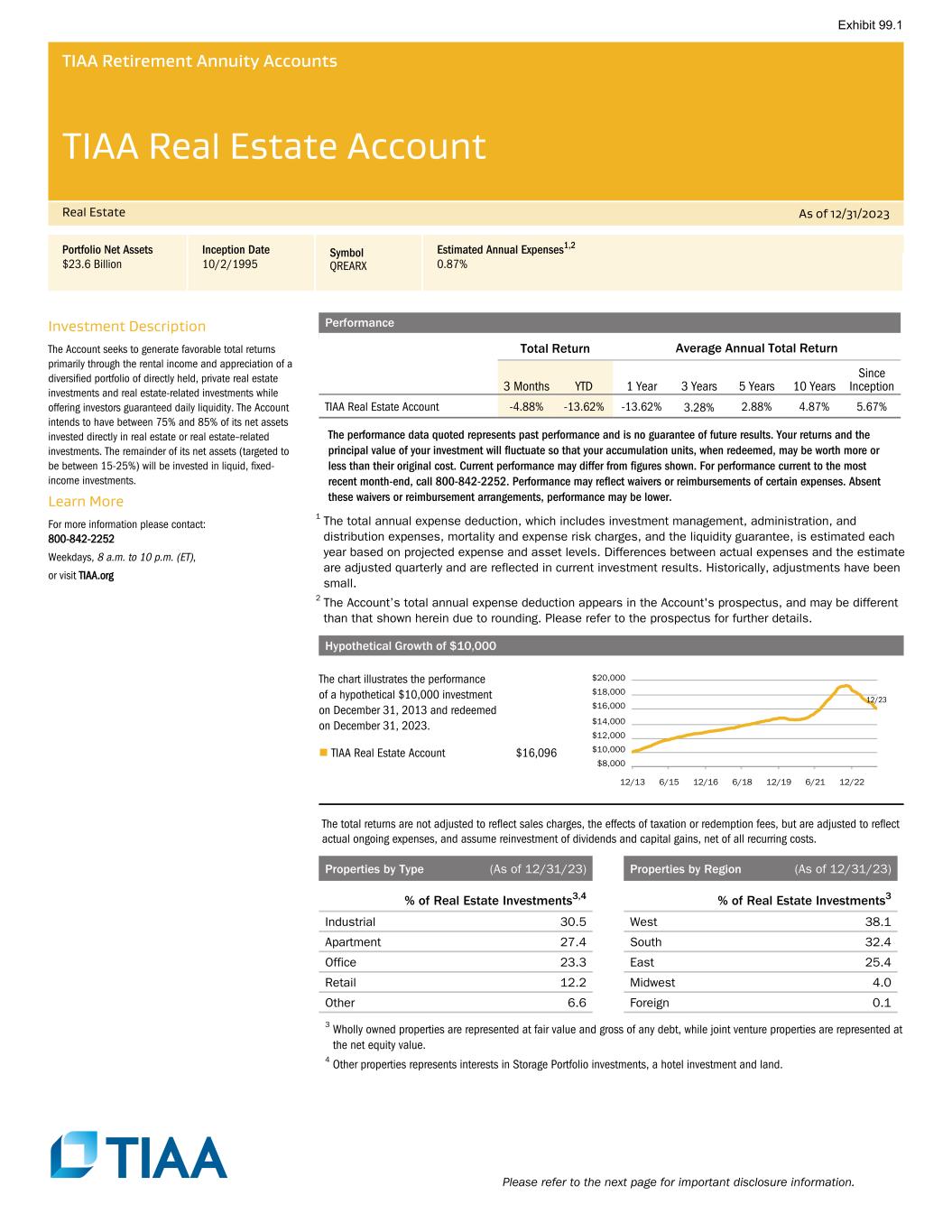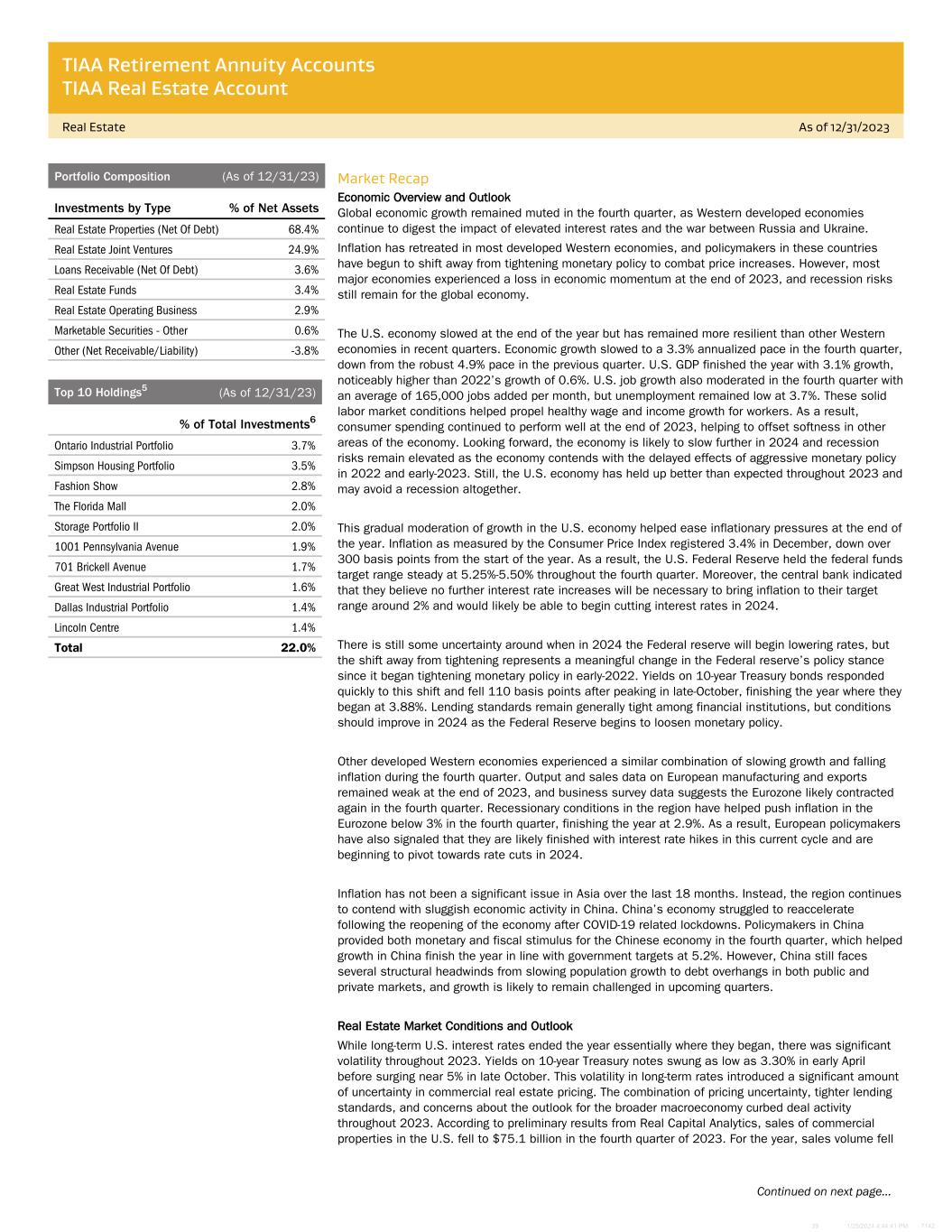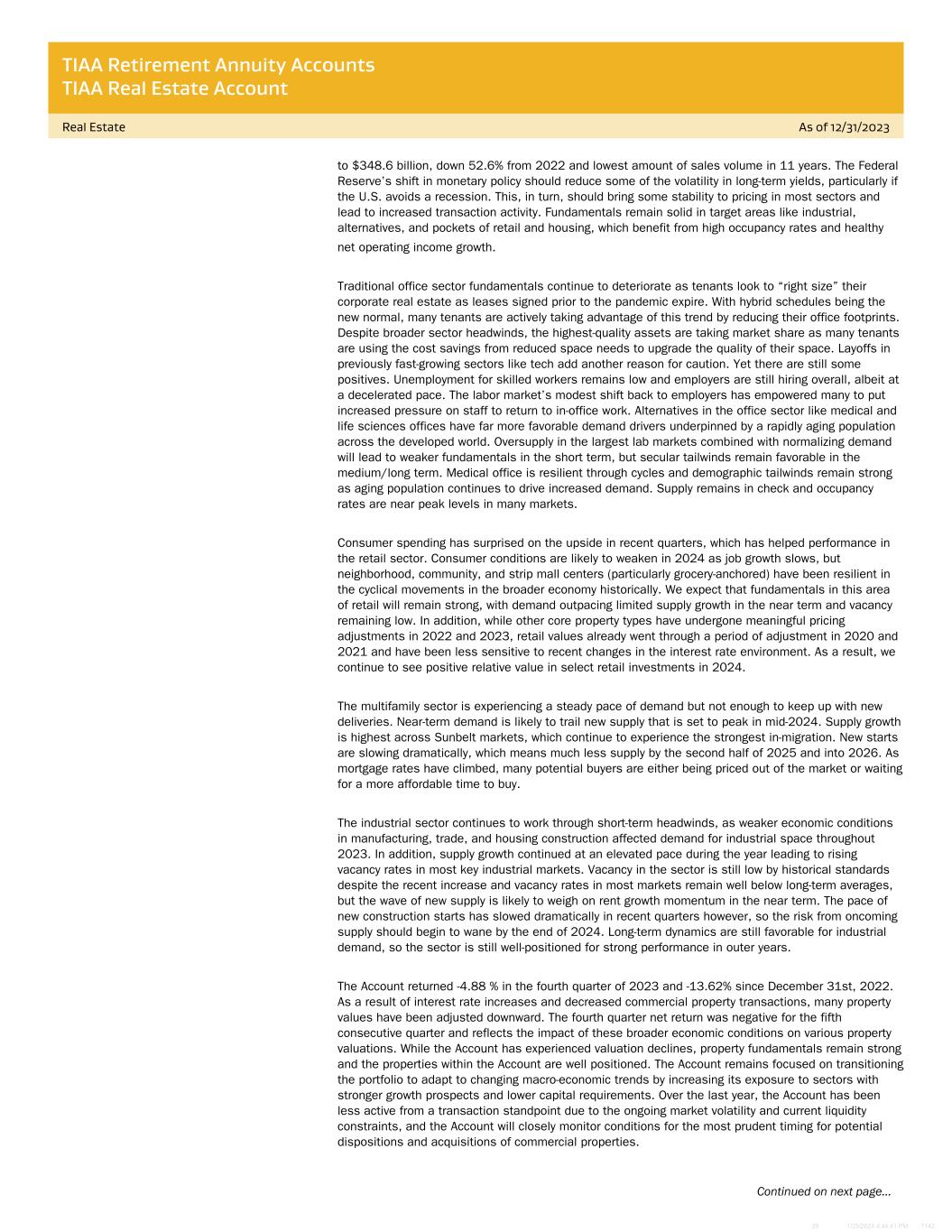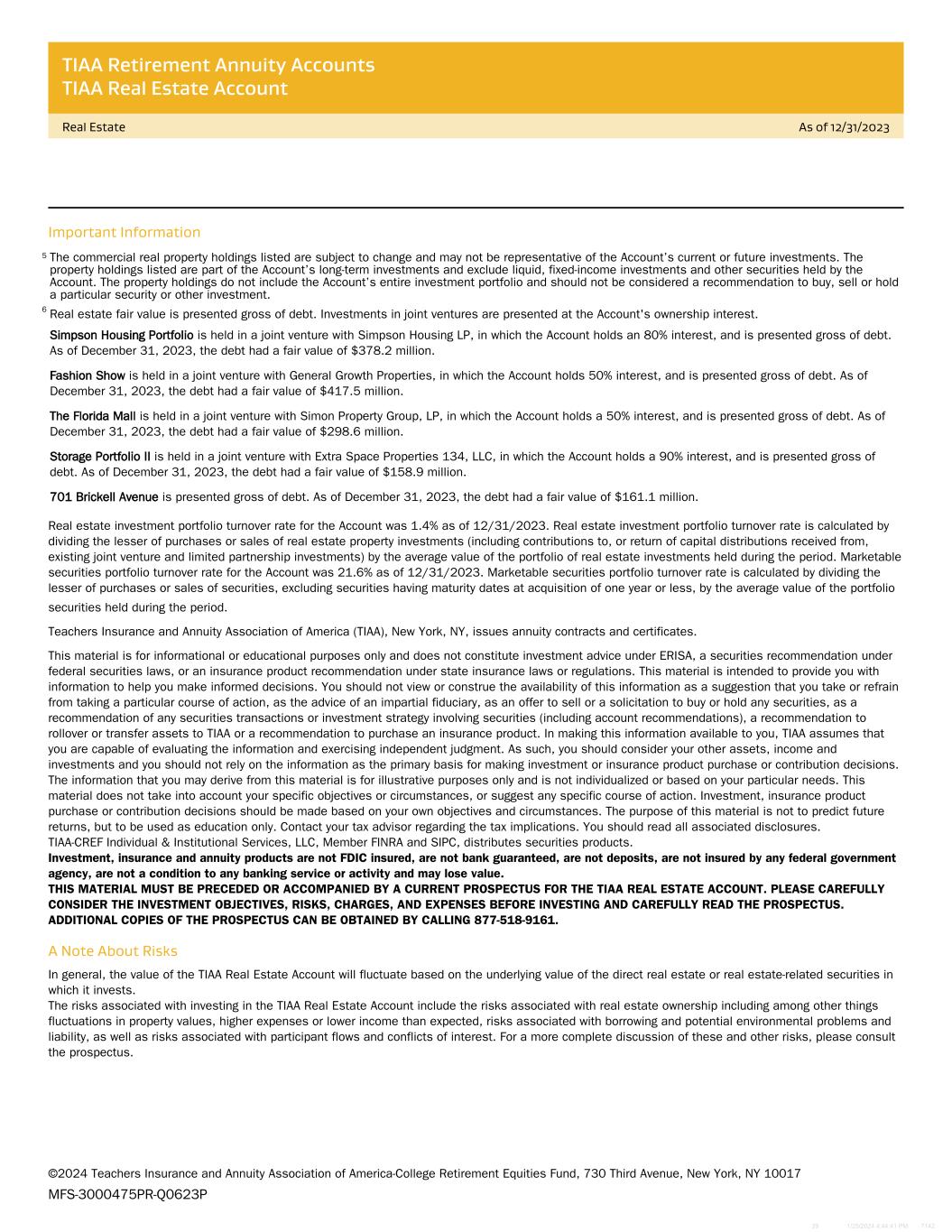
TIAA Retirement Annuity Accounts TIAA Real Estate Account Real Estate As of 12/31/2023 Portfolio Net Assets Inception Date Symbol Estimated Annual Expenses1,2 $23.6 Billion 10/2/1995 QREARX 0.87% Investment Description The Account seeks to generate favorable total returns primarily through the rental income and appreciation of a diversified portfolio of directly held, private real estate investments and real estate-related investments while offering investors guaranteed daily liquidity. The Account intends to have between 75% and 85% of its net assets invested directly in real estate or real estate–related investments. The remainder of its net assets (targeted to be between 15-25%) will be invested in liquid, fixed- income investments. Learn More For more information please contact: 800-842-2252 Weekdays, 8 a.m. to 10 p.m. (ET), or visit TIAA.org Please refer to the next page for important disclosure information. Performance Total Return Average Annual Total Return 3 Months YTD 1 Year 3 Years 5 Years 10 Years Since Inception TIAA Real Estate Account -4.88% -13.62% -13.62% 3.28% 2.88% 4.87% 5.67% The performance data quoted represents past performance and is no guarantee of future results. Your returns and the principal value of your investment will fluctuate so that your accumulation units, when redeemed, may be worth more or less than their original cost. Current performance may differ from figures shown. For performance current to the most recent month-end, call 800-842-2252. Performance may reflect waivers or reimbursements of certain expenses. Absent these waivers or reimbursement arrangements, performance may be lower. 1 The total annual expense deduction, which includes investment management, administration, and distribution expenses, mortality and expense risk charges, and the liquidity guarantee, is estimated each year based on projected expense and asset levels. Differences between actual expenses and the estimate are adjusted quarterly and are reflected in current investment results. Historically, adjustments have been small. 2 The Account’s total annual expense deduction appears in the Account's prospectus, and may be different than that shown herein due to rounding. Please refer to the prospectus for further details. Hypothetical Growth of $10,000 The chart illustrates the performance of a hypothetical $10,000 investment on December 31, 2013 and redeemed on December 31, 2023. n TIAA Real Estate Account $16,096 The total returns are not adjusted to reflect sales charges, the effects of taxation or redemption fees, but are adjusted to reflect actual ongoing expenses, and assume reinvestment of dividends and capital gains, net of all recurring costs. Properties by Type (As of 12/31/23) % of Real Estate Investments3,4 Industrial 30.5 Apartment 27.4 Office 23.3 Retail 12.2 Other 6.6 3 Wholly owned properties are represented at fair value and gross of any debt, while joint venture properties are represented at the net equity value. 4 Other properties represents interests in Storage Portfolio investments, a hotel investment and land. Properties by Region (As of 12/31/23) % of Real Estate Investments3 West 38.1 South 32.4 East 25.4 Midwest 4.0 Foreign 0.1 Exhibit 99.1

TIAA Retirement Annuity Accounts TIAA Real Estate Account Real Estate As of 12/31/2023 Continued on next page... 39 1/25/2024 4:44:41 PM 7142 Portfolio Composition (As of 12/31/23) Investments by Type % of Net Assets Real Estate Properties (Net Of Debt) 68.4% Real Estate Joint Ventures 24.9% Loans Receivable (Net Of Debt) 3.6% Real Estate Funds 3.4% Real Estate Operating Business 2.9% Marketable Securities - Other 0.6% Other (Net Receivable/Liability) -3.8% Top 10 Holdings5 (As of 12/31/23) % of Total Investments6 Ontario Industrial Portfolio 3.7% Simpson Housing Portfolio 3.5% Fashion Show 2.8% The Florida Mall 2.0% Storage Portfolio II 2.0% 1001 Pennsylvania Avenue 1.9% 701 Brickell Avenue 1.7% Great West Industrial Portfolio 1.6% Dallas Industrial Portfolio 1.4% Lincoln Centre 1.4% Total 22.0% Market Recap Economic Overview and Outlook Global economic growth remained muted in the fourth quarter, as Western developed economies continue to digest the impact of elevated interest rates and the war between Russia and Ukraine. Inflation has retreated in most developed Western economies, and policymakers in these countries have begun to shift away from tightening monetary policy to combat price increases. However, most major economies experienced a loss in economic momentum at the end of 2023, and recession risks still remain for the global economy. The U.S. economy slowed at the end of the year but has remained more resilient than other Western economies in recent quarters. Economic growth slowed to a 3.3% annualized pace in the fourth quarter, down from the robust 4.9% pace in the previous quarter. U.S. GDP finished the year with 3.1% growth, noticeably higher than 2022’s growth of 0.6%. U.S. job growth also moderated in the fourth quarter with an average of 165,000 jobs added per month, but unemployment remained low at 3.7%. These solid labor market conditions helped propel healthy wage and income growth for workers. As a result, consumer spending continued to perform well at the end of 2023, helping to offset softness in other areas of the economy. Looking forward, the economy is likely to slow further in 2024 and recession risks remain elevated as the economy contends with the delayed effects of aggressive monetary policy in 2022 and early-2023. Still, the U.S. economy has held up better than expected throughout 2023 and may avoid a recession altogether. This gradual moderation of growth in the U.S. economy helped ease inflationary pressures at the end of the year. Inflation as measured by the Consumer Price Index registered 3.4% in December, down over 300 basis points from the start of the year. As a result, the U.S. Federal Reserve held the federal funds target range steady at 5.25%-5.50% throughout the fourth quarter. Moreover, the central bank indicated that they believe no further interest rate increases will be necessary to bring inflation to their target range around 2% and would likely be able to begin cutting interest rates in 2024. There is still some uncertainty around when in 2024 the Federal reserve will begin lowering rates, but the shift away from tightening represents a meaningful change in the Federal reserve’s policy stance since it began tightening monetary policy in early-2022. Yields on 10-year Treasury bonds responded quickly to this shift and fell 110 basis points after peaking in late-October, finishing the year where they began at 3.88%. Lending standards remain generally tight among financial institutions, but conditions should improve in 2024 as the Federal Reserve begins to loosen monetary policy. Other developed Western economies experienced a similar combination of slowing growth and falling inflation during the fourth quarter. Output and sales data on European manufacturing and exports remained weak at the end of 2023, and business survey data suggests the Eurozone likely contracted again in the fourth quarter. Recessionary conditions in the region have helped push inflation in the Eurozone below 3% in the fourth quarter, finishing the year at 2.9%. As a result, European policymakers have also signaled that they are likely finished with interest rate hikes in this current cycle and are beginning to pivot towards rate cuts in 2024. Inflation has not been a significant issue in Asia over the last 18 months. Instead, the region continues to contend with sluggish economic activity in China. China’s economy struggled to reaccelerate following the reopening of the economy after COVID-19 related lockdowns. Policymakers in China provided both monetary and fiscal stimulus for the Chinese economy in the fourth quarter, which helped growth in China finish the year in line with government targets at 5.2%. However, China still faces several structural headwinds from slowing population growth to debt overhangs in both public and private markets, and growth is likely to remain challenged in upcoming quarters. Real Estate Market Conditions and Outlook While long-term U.S. interest rates ended the year essentially where they began, there was significant volatility throughout 2023. Yields on 10-year Treasury notes swung as low as 3.30% in early April before surging near 5% in late October. This volatility in long-term rates introduced a significant amount of uncertainty in commercial real estate pricing. The combination of pricing uncertainty, tighter lending standards, and concerns about the outlook for the broader macroeconomy curbed deal activity throughout 2023. According to preliminary results from Real Capital Analytics, sales of commercial properties in the U.S. fell to $75.1 billion in the fourth quarter of 2023. For the year, sales volume fell

TIAA Retirement Annuity Accounts TIAA Real Estate Account Real Estate As of 12/31/2023 Continued on next page... 39 1/25/2024 4:44:41 PM 7142 to $348.6 billion, down 52.6% from 2022 and lowest amount of sales volume in 11 years. The Federal Reserve’s shift in monetary policy should reduce some of the volatility in long-term yields, particularly if the U.S. avoids a recession. This, in turn, should bring some stability to pricing in most sectors and lead to increased transaction activity. Fundamentals remain solid in target areas like industrial, alternatives, and pockets of retail and housing, which benefit from high occupancy rates and healthy net operating income growth. Traditional office sector fundamentals continue to deteriorate as tenants look to “right size” their corporate real estate as leases signed prior to the pandemic expire. With hybrid schedules being the new normal, many tenants are actively taking advantage of this trend by reducing their office footprints. Despite broader sector headwinds, the highest-quality assets are taking market share as many tenants are using the cost savings from reduced space needs to upgrade the quality of their space. Layoffs in previously fast-growing sectors like tech add another reason for caution. Yet there are still some positives. Unemployment for skilled workers remains low and employers are still hiring overall, albeit at a decelerated pace. The labor market’s modest shift back to employers has empowered many to put increased pressure on staff to return to in-office work. Alternatives in the office sector like medical and life sciences offices have far more favorable demand drivers underpinned by a rapidly aging population across the developed world. Oversupply in the largest lab markets combined with normalizing demand will lead to weaker fundamentals in the short term, but secular tailwinds remain favorable in the medium/long term. Medical office is resilient through cycles and demographic tailwinds remain strong as aging population continues to drive increased demand. Supply remains in check and occupancy rates are near peak levels in many markets. Consumer spending has surprised on the upside in recent quarters, which has helped performance in the retail sector. Consumer conditions are likely to weaken in 2024 as job growth slows, but neighborhood, community, and strip mall centers (particularly grocery-anchored) have been resilient in the cyclical movements in the broader economy historically. We expect that fundamentals in this area of retail will remain strong, with demand outpacing limited supply growth in the near term and vacancy remaining low. In addition, while other core property types have undergone meaningful pricing adjustments in 2022 and 2023, retail values already went through a period of adjustment in 2020 and 2021 and have been less sensitive to recent changes in the interest rate environment. As a result, we continue to see positive relative value in select retail investments in 2024. The multifamily sector is experiencing a steady pace of demand but not enough to keep up with new deliveries. Near-term demand is likely to trail new supply that is set to peak in mid-2024. Supply growth is highest across Sunbelt markets, which continue to experience the strongest in-migration. New starts are slowing dramatically, which means much less supply by the second half of 2025 and into 2026. As mortgage rates have climbed, many potential buyers are either being priced out of the market or waiting for a more affordable time to buy. The industrial sector continues to work through short-term headwinds, as weaker economic conditions in manufacturing, trade, and housing construction affected demand for industrial space throughout 2023. In addition, supply growth continued at an elevated pace during the year leading to rising vacancy rates in most key industrial markets. Vacancy in the sector is still low by historical standards despite the recent increase and vacancy rates in most markets remain well below long-term averages, but the wave of new supply is likely to weigh on rent growth momentum in the near term. The pace of new construction starts has slowed dramatically in recent quarters however, so the risk from oncoming supply should begin to wane by the end of 2024. Long-term dynamics are still favorable for industrial demand, so the sector is still well-positioned for strong performance in outer years. The Account returned -4.88 % in the fourth quarter of 2023 and -13.62% since December 31st, 2022. As a result of interest rate increases and decreased commercial property transactions, many property values have been adjusted downward. The fourth quarter net return was negative for the fifth consecutive quarter and reflects the impact of these broader economic conditions on various property valuations. While the Account has experienced valuation declines, property fundamentals remain strong and the properties within the Account are well positioned. The Account remains focused on transitioning the portfolio to adapt to changing macro-economic trends by increasing its exposure to sectors with stronger growth prospects and lower capital requirements. Over the last year, the Account has been less active from a transaction standpoint due to the ongoing market volatility and current liquidity constraints, and the Account will closely monitor conditions for the most prudent timing for potential dispositions and acquisitions of commercial properties.

TIAA Retirement Annuity Accounts TIAA Real Estate Account Real Estate As of 12/31/2023 Continued on next page... 39 1/25/2024 4:44:41 PM 7142 Important Information 5 The commercial real property holdings listed are subject to change and may not be representative of the Account’s current or future investments. The property holdings listed are part of the Account’s long-term investments and exclude liquid, fixed-income investments and other securities held by the Account. The property holdings do not include the Account’s entire investment portfolio and should not be considered a recommendation to buy, sell or hold a particular security or other investment. 6 Real estate fair value is presented gross of debt. Investments in joint ventures are presented at the Account's ownership interest. Simpson Housing Portfolio is held in a joint venture with Simpson Housing LP, in which the Account holds an 80% interest, and is presented gross of debt. As of December 31, 2023, the debt had a fair value of $378.2 million. Fashion Show is held in a joint venture with General Growth Properties, in which the Account holds 50% interest, and is presented gross of debt. As of December 31, 2023, the debt had a fair value of $417.5 million. The Florida Mall is held in a joint venture with Simon Property Group, LP, in which the Account holds a 50% interest, and is presented gross of debt. As of December 31, 2023, the debt had a fair value of $298.6 million. Storage Portfolio II is held in a joint venture with Extra Space Properties 134, LLC, in which the Account holds a 90% interest, and is presented gross of debt. As of December 31, 2023, the debt had a fair value of $158.9 million. 701 Brickell Avenue is presented gross of debt. As of December 31, 2023, the debt had a fair value of $161.1 million. Real estate investment portfolio turnover rate for the Account was 1.4% as of 12/31/2023. Real estate investment portfolio turnover rate is calculated by dividing the lesser of purchases or sales of real estate property investments (including contributions to, or return of capital distributions received from, existing joint venture and limited partnership investments) by the average value of the portfolio of real estate investments held during the period. Marketable securities portfolio turnover rate for the Account was 21.6% as of 12/31/2023. Marketable securities portfolio turnover rate is calculated by dividing the lesser of purchases or sales of securities, excluding securities having maturity dates at acquisition of one year or less, by the average value of the portfolio securities held during the period. Teachers Insurance and Annuity Association of America (TIAA), New York, NY, issues annuity contracts and certificates. This material is for informational or educational purposes only and does not constitute investment advice under ERISA, a securities recommendation under federal securities laws, or an insurance product recommendation under state insurance laws or regulations. This material is intended to provide you with information to help you make informed decisions. You should not view or construe the availability of this information as a suggestion that you take or refrain from taking a particular course of action, as the advice of an impartial fiduciary, as an offer to sell or a solicitation to buy or hold any securities, as a recommendation of any securities transactions or investment strategy involving securities (including account recommendations), a recommendation to rollover or transfer assets to TIAA or a recommendation to purchase an insurance product. In making this information available to you, TIAA assumes that you are capable of evaluating the information and exercising independent judgment. As such, you should consider your other assets, income and investments and you should not rely on the information as the primary basis for making investment or insurance product purchase or contribution decisions. The information that you may derive from this material is for illustrative purposes only and is not individualized or based on your particular needs. This material does not take into account your specific objectives or circumstances, or suggest any specific course of action. Investment, insurance product purchase or contribution decisions should be made based on your own objectives and circumstances. The purpose of this material is not to predict future returns, but to be used as education only. Contact your tax advisor regarding the tax implications. You should read all associated disclosures. TIAA-CREF Individual & Institutional Services, LLC, Member FINRA and SIPC, distributes securities products. Investment, insurance and annuity products are not FDIC insured, are not bank guaranteed, are not deposits, are not insured by any federal government agency, are not a condition to any banking service or activity and may lose value. THIS MATERIAL MUST BE PRECEDED OR ACCOMPANIED BY A CURRENT PROSPECTUS FOR THE TIAA REAL ESTATE ACCOUNT. PLEASE CAREFULLY CONSIDER THE INVESTMENT OBJECTIVES, RISKS, CHARGES, AND EXPENSES BEFORE INVESTING AND CAREFULLY READ THE PROSPECTUS. ADDITIONAL COPIES OF THE PROSPECTUS CAN BE OBTAINED BY CALLING 877-518-9161. A Note About Risks In general, the value of the TIAA Real Estate Account will fluctuate based on the underlying value of the direct real estate or real estate-related securities in which it invests. The risks associated with investing in the TIAA Real Estate Account include the risks associated with real estate ownership including among other things fluctuations in property values, higher expenses or lower income than expected, risks associated with borrowing and potential environmental problems and liability, as well as risks associated with participant flows and conflicts of interest. For a more complete discussion of these and other risks, please consult the prospectus. ©2024 Teachers Insurance and Annuity Association of America-College Retirement Equities Fund, 730 Third Avenue, New York, NY 10017 MFS-3000475PR-Q0623P



